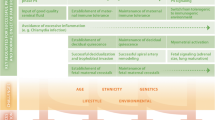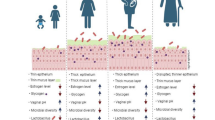Abstract
Annexin A1 (AnxA1) is a glucocorticoid-inducible protein and an important endogenous modulator of inflammation. However, its effect in the endometrial microenvironment is poorly explained. This study aimed to evaluate the role of endogenous AnxA1 in an endometritis mouse model induced by lipopolysaccharide (LPS). Female C57BL/6 wild-type (WT) and AnxA1−/− mice were divided into two groups: SHAM and LPS. To induce endometritis, mice received a vaginal infusion of 50 μL of LPS (1 mg/mL) dissolved in phosphate-buffered saline. After 24 h, the mice were euthanized, and blood and uteri samples were collected. The endometrium inflammatory scores were significantly increased in the LPS-treated group. AnxA1−/− mice from the LPS group demonstrated a significant increase in the number of degranulated mast cell levels compared to AnxA1−/− SHAM mice. The Western blotting analysis revealed that a lack of AnxA1 promoted the upregulation of NLRP3 and pro-IL-1β in the acute endometritis animal model compared to WT LPS animals. LPS-induced endometritis increased the number of blood peripheral leukocytes in both WT and AnxA1−/− mice compared with SHAM group mice (p < 0.001). AnxA1−/− mice also showed increased plasma levels of IL-1β (p < 0.01), IL-6, IL-10, IL-17, and TNF-α (p < 0.05) following LPS-induced endometritis. In conclusion, a lack of endogenous AnxA1 exacerbated the inflammatory response in an endometritis model via NLRP3 dysregulation, increased uterine mast cell activation, and plasma pro-inflammatory cytokine release.





Similar content being viewed by others
Data Availability
The data that support the findings of this study are available from the corresponding author, upon reasonable request.
References
Kitaya, K., et al. 2018. Endometritis: new time, new concepts. Fertility and Sterility 110 (3): 344–350.
Kiviat, N.B., et al. 1990. Endometrial histopathology in patients with culture-proved upper genital tract infection and laparoscopically diagnosed acute salpingitis. American Journal of Surgical Pathology 14 (2): 167–175.
Haggerty, C.L., et al. 2003. Endometritis does not predict reproductive morbidity after pelvic inflammatory disease. American Journal of Obstetrics and Gynecology 188 (1): 141–148.
Greenwood, S.M., and J.J. Moran. 1981. Chronic endometritis: morphologic and clinical observations. Obstetrics and Gynecology 58 (2): 176–184.
Singh, N., and A. Sethi. 2022. Endometritis - diagnosis, treatment and its impact on fertility - a scoping review. JBRA Assisted Reproduction 26 (3): 538–546.
Lampiasi, N. 2022. Interactions between macrophages and mast cells in the female reproductive system. International Journal of Molecular Sciences 23 (10): 5414.
Wang, W., et al. 2020. Single-cell transcriptomic atlas of the human endometrium during the menstrual cycle. Nature Medicine 26 (10): 1644–1653.
Zenclussen, A.C., and G.J. Hämmerling. 2015. Cellular regulation of the uterine microenvironment that enables embryo implantation. Frontiers in Immunology 6: 321.
Sugimoto, M.A., et al. 2016. Annexin A1 and the resolution of inflammation: modulation of neutrophil recruitment, apoptosis, and clearance. Journal of Immunology Research 2016: 8239258.
Perretti, M., and F. D’Acquisto. 2009. Annexin A1 and glucocorticoids as effectors of the resolution of inflammation. Nature Reviews Immunology 9 (1): 62–70.
Oliani, S.M., et al. 2002. Annexin 1 localisation in tissue eosinophils as detected by electron microscopy. Mediators of Inflammation 11 (5): 287–292.
Gil, C.D., et al. 2006. Interaction of human neutrophils with endothelial cells regulates the expression of endogenous proteins annexin 1, galectin-1 and galectin-3. Cell Biology International 30 (4): 338–344.
Hannon, R., et al. 2003. Aberrant inflammation and resistance to glucocorticoids in annexin 1-/- mouse. The FASEB Journal 17 (2): 253–255.
Yang, Y.H., et al. 2013. Deficiency of annexin A1 in CD4+ T cells exacerbates T cell-dependent inflammation. The Journal of Immunology 190 (3): 997–1007.
Gimenes, A.D., et al. 2015. Beneficial effect of annexin A1 in a model of experimental allergic conjunctivitis. Experimental Eye Research 134: 24–32.
Gavins, F.N., et al. 2012. Leukocyte recruitment in the brain in sepsis: involvement of the annexin 1-FPR2/ALX anti-inflammatory system. The FASEB Journal 26 (12): 4977–4989.
Sanches, J.M., et al. 2020. Annexin A1 regulates NLRP3 inflammasome activation and modifies lipid release profile in isolated peritoneal macrophages. Cells 9 (4): 926.
Wu, C., et al. 2022. Annexin A1 inhibition facilitates NLRP3 inflammasome activation in arsenic-induced insulin resistance in rat liver. Environmental Toxicology and Pharmacology 96: 103981.
Zhu, M., et al. 2022. Crosstalk between RPE cells and choroidal endothelial cells via the ANXA1/FPR2/SHP2/NLRP3 inflammasome/pyroptosis axis promotes choroidal neovascularization. Inflammation 45 (1): 414–427.
Zhang, Z., et al. 2022. Annexin-A1 tripeptide attenuates surgery-induced neuroinflammation and memory deficits through regulation the NLRP3 inflammasome. Frontiers in Immunology 13: 856254.
Broz, P., and V.M. Dixit. 2016. Inflammasomes: mechanism of assembly, regulation and signalling. Nature Reviews Immunology 16 (7): 407–420.
Swanson, K.V., et al. 2019. The NLRP3 inflammasome: molecular activation and regulation to therapeutics. Nature Reviews Immunology 19 (8): 477–489.
Yang, Y., et al. 2019. Recent advances in the mechanisms of NLRP3 inflammasome activation and its inhibitors. Cell Death & Disease 10 (2): 128.
Liang, Y., et al. 2018. Alpinetin ameliorates inflammatory response in LPS-induced endometritis in mice. International Immunopharmacology 62: 309–312.
Corrêa, M.P., et al. 2022. Expression pattern and immunoregulatory roles of galectin-1 and galectin-3 in atopic dermatitis and psoriasis. Inflammation 45 (3): 1133–1145.
Sridharan, G., and A.A. Shankar. 2012. Toluidine blue: a review of its chemistry and clinical utility. Journal of Oral and Maxillofacial Pathology 16 (2): 251–255.
Gao, Y., et al. 2023. Melatonin alleviates lipopolysaccharide-induced endometritis by inhibiting the activation of NLRP3 inflammasome through autophagy. Animals (Basel) 13 (15): 2449.
Zhang, M., et al. 2023. NLRP3 inflammasome-mediated pyroptosis induce Notch signal activation in endometriosis angiogenesis. Molecular and Cellular Endocrinology 574: 111952.
Zhang, H., et al. 2019. Catalpol ameliorates LPS-induced endometritis by inhibiting inflammation and TLR4/NF-κB signaling. Journal of Zhejiang University. Science. B 20 (10): 816–827.
Karmakar, M., et al. 2015. Neutrophil IL-1β processing induced by pneumolysin is mediated by the NLRP3/ASC inflammasome and caspase-1 activation and is dependent on K+ efflux. The Journal of Immunology 194 (4): 1763–1775.
Chen, K.W., et al. 2016. The murine neutrophil NLRP3 inflammasome is activated by soluble but not particulate or crystalline agonists. European Journal of Immunology 46 (4): 1004–1010.
Sanches, J.M., et al. 2021. The role of annexin A1 in Candida albicans and Candida auris infections in murine neutrophils. Microbial Pathogenesis 150: 104689.
Espinosa-Riquer, Z.P., et al. 2020. Signal transduction pathways activated by innate immunity in mast cells: translating sensing of changes into specific responses. Cells 9 (11): 2411.
Sawatsubashi, M., et al. 2000. Association of vascular endothelial growth factor and mast cells with angiogenesis in laryngeal squamous cell carcinoma. Virchows Archiv 436 (3): 243–248.
Elieh Ali Komi, D., et al. 2020. Mast cell biology at molecular level: a comprehensive review. Clinical Reviews in Allergy and Immunology 58 (3): 342–365.
Parisi, J.D.S., et al. 2019. Lack of endogenous annexin A1 increases mast cell activation and exacerbates experimental atopic dermatitis. Cells 8 (1): 51.
Yazid, S., et al. 2010. Anti-allergic drugs and the annexin-A1 system. Pharmacological Reports 62 (3): 511–517.
Yazid, S., et al. 2013. Anti-allergic cromones inhibit histamine and eicosanoid release from activated human and murine mast cells by releasing Annexin A1. PLoS ONE 8 (3): e58963.
Di, M., et al. 2022. Epigallocatechin-3-gallate (EGCG) attenuates inflammatory responses and oxidative stress in lipopolysaccharide (LPS)-induced endometritis via silent information regulator transcript-1 (SIRT1)/nucleotide oligomerization domain (NOD)-like receptor pyrin domain-containing 3 (NLRP3) pathway. Journal of Biochemical and Molecular Toxicology 36 (12): e23203.
Hu, X., et al. 2018. Melatonin inhibits endoplasmic reticulum stress-associated TXNIP/NLRP3 inflammasome activation in lipopolysaccharide-induced endometritis in mice. International Immunopharmacology 64: 101–109.
Li, L., et al. 2023. Protective effect of the total flavonoids from Clinopodium chinense against LPS-induced mice endometritis by inhibiting NLRP3 inflammasome-mediated pyroptosis. Journal of Ethnopharmacology 312: 116489.
Wang, Z., et al. 2023. UFM1 inhibits the activation of the pyroptosis in LPS-induced goat endometritis. Theriogenology 196: 50–58.
Shen, W., et al. 2022. Neutrophil extracellular traps mediate bovine endometrial epithelial cell pyroptosis in dairy cows with endometritis. International Journal of Molecular Sciences 23 (22): 14013.
Guo, X., et al. 2021. NLRP3 inflammasome activation of mast cells by estrogen. Frontiers in Immunology 12: 749979.
Patel, H.B., et al. 2012. The impact of endogenous annexin A1 on glucocorticoid control of inflammatory arthritis. Annals of the Rheumatic Diseases 71 (11): 1872–1880.
Tortorella, C., et al. 2014. Interleukin-6, interleukin-1β, and tumor necrosis factor α in menstrual effluents as biomarkers of chronic endometritis. Fertility and Sterility 101 (1): 242–247.
Hickey, D.K., et al. 2013. Mouse estrous cycle regulation of vaginal versus uterine cytokines, chemokines, α-/β-defensins and TLRs. Innate Immunity 19 (2): 121–131.
Acknowledgements
This research was funded by the Fundação ao de Amparo à Pesquisa do Estado de São Paulo - FAPESP [grant number 22/02327-6]. RRV was supported by the Coordenação ao de Aperfeiçoamento de Pessoal de Nível Superior (CAPES-Finance code 001) scholarship. CDG is a researcher fellow of the Conselho Nacional de Desenvolvimento Científico e Tecnologico (CNPq). AAFC was supported by the CAPES-Print scholarship.
Author information
Authors and Affiliations
Contributions
Conceptualization: RRV, CDG, AAFC; Methodology: RRV, RAS, GRSS, PCF, FTB, JMS; Formal analysis: RRV, RAS, PL, CDG, AAFC. Investigation and Data curation: RRV. Writing-original draft preparation: RRV, JMS; Writing-review and editing: PL, CDG, AAFC. Project administration and Funding acquisition: CDG; Supervision: CDG, AAFC.
Corresponding author
Ethics declarations
Competing Interest
The authors declare no competing interests.
Additional information
Publisher's Note
Springer Nature remains neutral with regard to jurisdictional claims in published maps and institutional affiliations.
Rights and permissions
Springer Nature or its licensor (e.g. a society or other partner) holds exclusive rights to this article under a publishing agreement with the author(s) or other rightsholder(s); author self-archiving of the accepted manuscript version of this article is solely governed by the terms of such publishing agreement and applicable law.
About this article
Cite this article
Vieira, R.R., da Silva, R.A., Sasso, G.R.S. et al. Lack of Annexin A1 Exacerbates Inflammatory Response in Acute Endometritis Model. Inflammation (2024). https://doi.org/10.1007/s10753-023-01959-3
Received:
Revised:
Accepted:
Published:
DOI: https://doi.org/10.1007/s10753-023-01959-3




